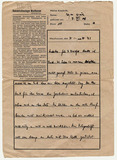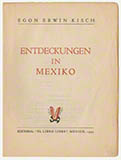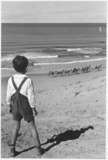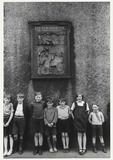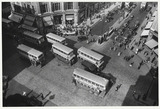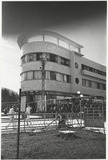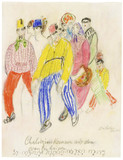Edgar Weil: Letter to Grete Weil (31 August 1941)
After a failed escape attempt in May 1940, Edgar and Grete Weil had planned to emigrate from Holland in the summer of 1941 with a Cuban tourist visa. While the writer and photographer had her visa already, her husband planned to collect his on 11 June 1941 in Rotterdam.
Eduard Korrodi: Deutsche Literatur im Emigrantenspiegel [German Literature as Reflected by Emigrants] (1936)
With his article German Literature as Reflected by Emigrants, which appeared in the Neue Zürcher Zeitung on 26 January 1936, the Swiss literary correspondent Eduard Korrodi (1885-1955) provoked Thomas Mann to write an open letter in response, in which he made his contempt for the Nazi regime public for the first time.
Egon Erwin Kisch: Discoveries in Mexico (1945)
The essays and reports of Egon Erwin Kisch published in Mexico City in 1945 by El Libro Libre entitled Entdeckungen in Mexiko were his second book by this publisher; in 1942 he had already released Marktplatz der Sensationen (1942). The reports collected in his second book had been published in exile magazines since the early 1940s, especially in the magazine Freies Deutschland.
Ellen Auerbach: Beach near Tel Aviv, photograph (1934)
When the photographer Ellen Auerbach emigrated to Palestine in December 1933 she had previously mainly worked as a studio photographer in Berlin. She had trained under Walter Peterhans, who later became a lecturer at the Bauhaus art school.
Ellen Auerbach: Buenos Aires after the Rain (1946)
Photographic portrait of a new dawn?For those who emigrated to North or South America, exile didn’t simply come to an end in 1945. Anyone wishing to return required departure and entry permits, which could take several years to come through.
Ellen Auerbach: Photograph of Little Dorrit’s Playground (1936)
The working style of photographer Ellen Auerbach underwent a sustainable transformation in Palestine. Instead of still lives, she began choosing everyday scenes and people as the motifs for her photographs.
Ellen Auerbach: Photograph of Oxford Circus (1936)
When the photographer Ellen Auerbach left Palestine for London in 1936, she met up with her colleague and friend Grete Stern there, with whom she had run the ringl+pit photo studio in Berlin since 1929. Auerbach took on some commissioned works for Grete Stern‘s photo studio, and she also portrayed many well-known people like Bertolt Brecht, for example.
Ellen Auerbach: photograph of Studio Ishon (circa 1935)
After some initial hitches in Palestine, where Ellen Auerbach had emigrated to in December 1933, she opened a photographic studio in Tel Aviv with her friend Liselotte Grschebina in 1934. The two photographers had known each other since their childhood in Karlsruhe.
Else Lasker- Schüler: Letter to Emil Raas (1933)
After the National Socialists took power in January 1933, the poet Else Lasker-Schüler immigrated to Switzerland, where she was allowed to stay for a few years. The destitute foreigner, who was never granted a work permit, nonetheless faced many obstacles.
Else Lasker-Schüler: Chaluzim kommen aus den Orangenhainen (c. 1935)
Prince Jussuf and his friends come to lifeElse Lasker-Schüler was in exile in Switzerland from April 1933. Her drawings were removed from the Berlin National Gallery in the wake of the "Degenerate Art" policy in 1937.
